Space Shuttle Launch Complex 39-B Construction Photos
Page 28
STS-2 Rollout, Cyclopean Structures
(Original Scan)
Mixed images.
Top left is the rollout to Pad A of STS-2. (Note the white external tank)
Top right is the same, from inside the RCS room on top of the RSS.
Bottom left is a view of the towers from our field trailer. Note how spare and bare things look. A lot got added on to both towers after this shot was taken.
Bottom right is looking down into the structural skeleton of the RSS.
Additional commentary below the image.
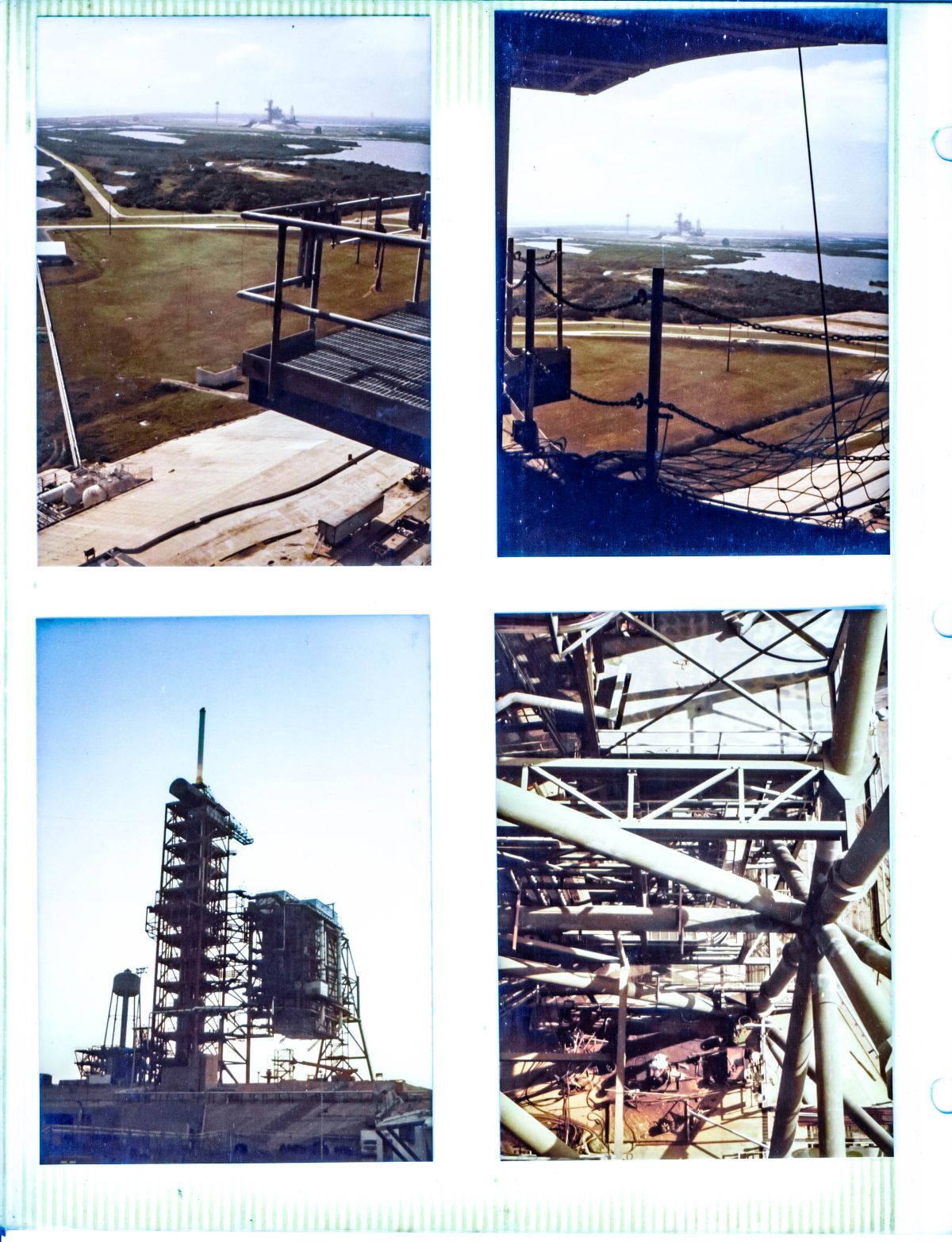
Top Left: (Full-size)
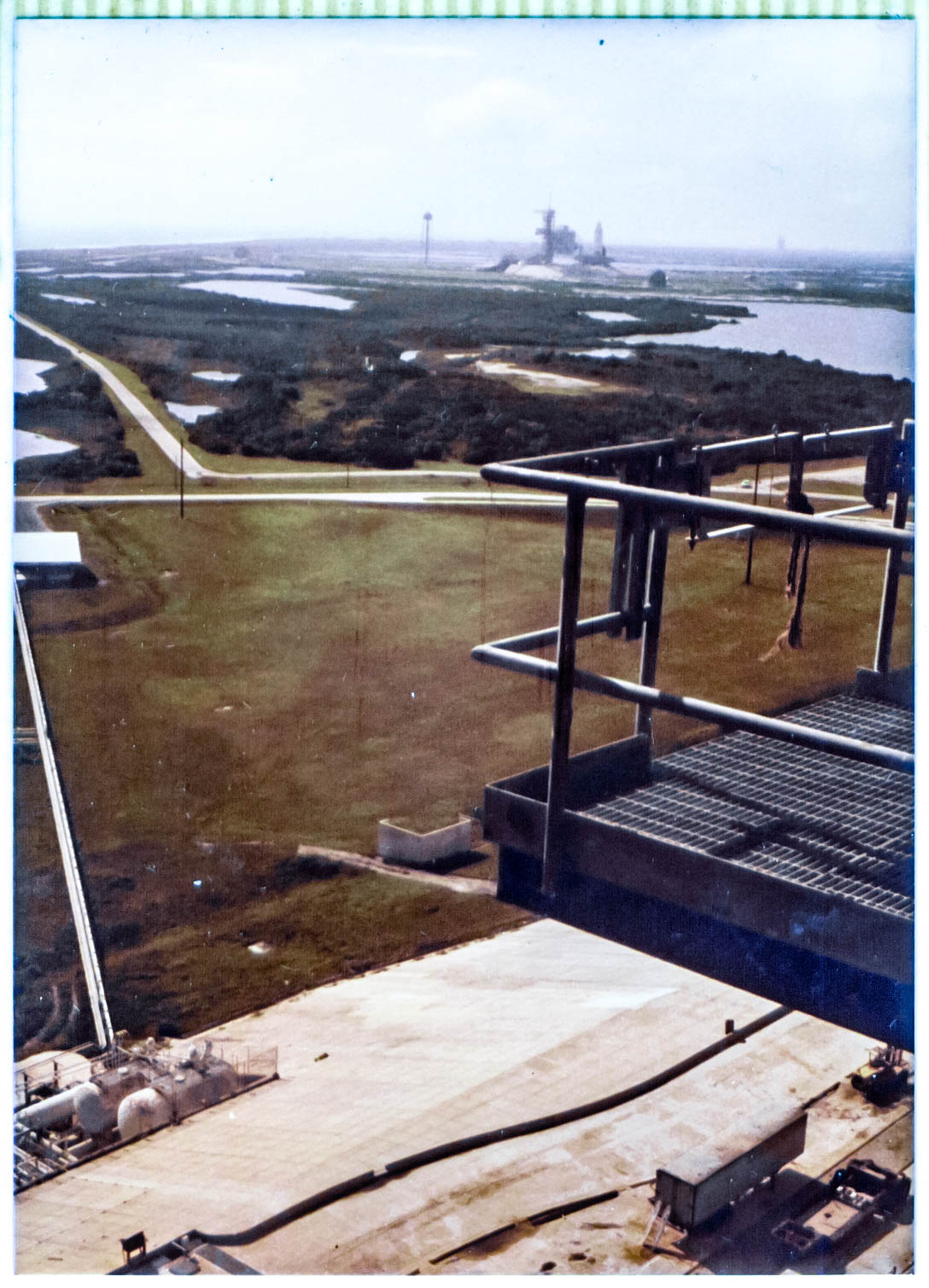
The more I look at this image, the more perplexed I become regarding the exact location it was taken from.
I'll return to that in a bit, but first, let's give some other things a closer look, ok?
I've ranted and raved about "safety" gates plenty enough already, but this is such a sterling shot of one of them that I cannot resist the compulsion to rant and rave further.
Please forgive me if you have it in your heart to do so.
And, in case you're wondering as to the cause of my deep-seated hatred of these goddamned things, it's because I was deeply involved with every last one of them, against my will, and they were just miserable fucking things, and there never was anything about them that I could recommend to anybody that I might wish to remain amongst the living.
I've mentioned before that one of my jobs out on the pad involved producing "field sketches" of things that could not be constructed owing to no end of differing problems and conditions that were at variance from what was shown on the fabrication and erection drawings, or simply not shown on those drawings at all, which resulted in a work stoppage and a flurry of paperwork to get things back on track and underway, once again.
So I went dredging through what little has remained of my days out there and, lo and behold, I found three sheets of paperwork concerning one of these "safety" gates.
This first sheet is an example of what gets produced when you clamber out onto the bare iron, clipboard with notepad stuffed into your trousers just above your butt, pencil clenched between teeth, tape measure hooked on to your belt at your right hip, try to find a stable place that you won't fall to your death from, and then take out the tape measure and reach around (steady now, don't fall) things to get the dimensions as they actually exist on the real iron as opposed to the imaginary iron that the contract drawing shows, maybe discuss things a little with an ironworker or ironworker foreman who's attempting with no luck to put the goddamned thing together, hook the tape back on your belt, pull out the clipboard, and then take your slobber-besmeared pencil from between your teeth and attempt to draw something that you might be able to recognize and make sense of, when you get back down on the ground in your field trailer and put together a nicer cleaner version that will be submitted with your RFI in an attempt to get some kind of sense out of the cognizant authorities that you must deal with in order to get anything done at all.
This second sheet is an example of the "nicer cleaner" version of your first field sketch, which is what gets submitted to the prime contractor, who then passes it along to NASA Engineering after having altered things such that they, the prime contractor, are best positioned to reap all rewards that may ensue, even as they push you into a position that leaves you fully exposed to such cross-hairs as may be centered directly upon you by parties unknowable.
And for your further edification, here is a corresponding contract drawing of the FSS and crossover catwalks at this same location, rotated to agree with the north-down (because that's how it looks, when you're out there on the iron) orientation of the cleaned-up field sketch.
And this third sheet is a delightfully nasty example of what comes back from them, which you may or may not be of a mind to accept, and may or may not decide to shoot their miserable sheet of paper right back in their faces with an additional RFI, in an attempt to get some small scrap of justice out of the system, or perhaps just try a little further to simply build the goddamned thing, instead of having to continue to sit around with your thumb up your ass, waiting, ....and waiting, ....and waiting for somebody, somewhere, to make some sense, somehow.
Ok, back to the story. Back to the image above. A couple of points of interest, if we may.
First off, get a good close look at the size of the opening below the lower edges of the swinging portion of the gate.
Maybe compare it with the fixed handrails on either side of it.
Nice, huh?
And how 'bout that cantilevered precipice, yawning lethally just on the other side of that plus-sized opening beneath the gate? Not even so much as any toe-plate that might stop a slide. Yeah, that kind of thing can really give you a case of the good old-fashioned cold shivers, no doubt about it.
Definitely not the kind of place you'd want to slip on a banana peel while you were distractedly sauntering along, eh?
They went to extraordinary lengths to ensure that the fixed handrails which are around every edge of every platform on both towers were strong enough to stop a speeding Buick (inch and a half schedule 40 steel pipe is serious stuff and that's what was used in almost all cases, unless there was a really good reason for not doing so), and those handrails always had an intermediate bar beneath their top bar (which sits at an elevation of 3'-6" on-center, above the surface of the steel bar grating or checkerplate), located midway (el. 1'-9" on-center above top of grating or deckplate), and the whole purpose of all this grossly overdesigned safety apparatus was to keep some unfortunate who chose the exact wrong place to stumble and fall, from going right on over the edge and down down down an awful drop to their certain demise, either on some intermediate steel somewhere, or perhaps the unyielding hardness of the pad deck itself, far below the lofty steel you're seeing in this image.
Serious consequences demand serious prevention measures, and ok, I'm just fine and dandy with that, and if, somehow, somebody was up on the tower driving their Buick around in an unsafe way and they missed a turn, that goddamned schedule 40 steel pipe, which was one-quarter inch, all-around fillet-welded to whatever much stronger platform framing it might be welded on top of, would stop that sonofabitch, here and now, no if's, and's, or but's about it.
And when it came to the serious prevention measures associated with handrail, there were very few exceptions.
But one of those exceptions was astoundingly unnecessary in the first place, and in the second place it was uniformly and consistently implemented in one of the worst possible locations you could come up with!
That exception, of course, was those horrid "safety" gates, which were located at the exact spots where it would be most likely that a distracted person might be expected to stumble against them unexpectedly.
What. Were. The. People. Who. Designed. This. Stuff. THINKING?
How hard would it have been to alter the design of the gates to bring them more into line with the handrails which they were affixed to?
How hard would it have been to fill that deadly gap up with some extra gate material a little better?
Boy, I dunno.
This thing is wrong in so many ways that it taxes my ability to enumerate them all.
Just look at it.
Look how flimsy it is compared to that handrail it's bolted to.
Not even close!
And it moves a little bit, even when it's "latched" so that if you blunder into it, it will not provide a rock-solid barrier against your continued fall, but will instead jump just enough to further disrupt your abilities to make a life-saving set of reflexive physical moves in the quarter second or so that you've been given to do so, before the fall continues.
Gah.
And that SPACE beneath the lower bar.
I'm just eyeballing it here, but it looks like it's plenty wide enough for the fattest person that might ever conceivably be found waddling around on the tower to pass right through it without so much as brushing against the lower edge of the thing.
Way, waaay, too much room underneath that gate.
Also, please note, that the ironworkers (who, remember, have jobs that place them out on top of naked steel beams and girders on a regular basis), do not trust this fucking thing either.
Somebody has very wisely taken one of the ropes that hold up the floats (Strong rope. Really strong rope.), and tied the two halves of the gate together with it, not trusting the latch mechanism of the gate itself in the slightest. And that's still not enough. They also were careful to let enough tag-end of rope dangle down into the mouth of that horrible horrible opening beneath the gate, just as a bit of visual insurance. A further bit of warning that this is not a nice place.
HooBOY.
And people wonder why the safety man comes in for as much flack as he does.
There are reasons. There are good and sufficient reasons.
Ok, enough of that. Calm down, MacLaren.
Let's return to my perplexity which I opened this little section with.
I wrote those words yesterday, and now here it is today, and by golly I think I've gotten my answer to the question. I shall not bore you with the details of just how much time and effort I put into figuring this one out, lest you, upon learning the answer, conclude that I am both blind and deeply stupid.
Here, have a look at this.
The platform depicted in the image above, on this page, is clearly visible in the image I just linked to, in the sentence above.
Zoom in full-size if necessary, and then get your bearings by locating the GOX arm hanging out into space on the left side of the FSS, just beneath the back end of the hammerhead crane way up at the very top of the FSS, and the Orbiter Access Arm down there below it, also hanging out into space to the left of the FSS, but with the top of the RSS behind it, to keep it from looking like it's any kind of separate thing from all of the rest of that bewildering complexity of steel framing.
Ok?
Ok.
On the left end of the OAA is the white rectangular shape of the white room which the crew of the Space Shuttle passed through on their way into the hatch on the side of the orbiter, and on the right end of the OAA, are the hinge boxes and associated steel framing that attaches it to the main structure of the FSS. In between, just above the white air-supply duct that runs along the length of the OAA truss, the darker shadowed undersides of two smallish FSS-RSS crossover platforms (located at elevation 220' on the FSS) can be seen. And our platform of interest is the one on the right.
So now you know what's going on, exactly.
-
Addendum: After getting my hands on the drawings that Manfred Rohr tipped me off to (again, my deepest thanks, Manfred), it suddenly became child's play to find the little platform I'm discussing above, but I'm leaving all those puzzle-solving words you just read, up above, in here anyway, just as a reminder of what you sometimes have to go through to figure out what you're looking at.
That platform set can be located on the drawing here, just as pretty as you please.
-
-
Second Addendum: And then I found my field sketches. From across a yawning gulf of thirty-five years, long-hidden sheets of paper, far too delicate to so much as survive the next winter, flutter impossibly into view and then fall directly into your disbelieving hands. A more-than-impossible thing. A thing that could never happen. And yet, here we stand, with every last bit of it neatly in place. I marvel at how the Hand of Fate moves me around on its Great Playing Field. I really do.
-
Ok. Enough of that. Quite a bit more than enough of that, actually. Let us move forward, shall we? Back to the image above, and what we might see therein.
Clearly, when I either noticed on my own, or got word (I have no recollection of that detail, it is gone forever.) that they were rolling out the bird to A-Pad, I must have headed up to the pad deck from our field trailer with my camera in hand, gotten in to the FSS elevator, and hit the "215" button (Remember, B-Pad was five feet higher than A-Pad, but to minimize confusion, they left the same numbers on things, and except for people like us who were actually building the damn thing and who actually needed to know the real elevations of things, it was much better for all concerned that they did so.) to get myself up nice and high for a good view of things a little over a mile and a half away, over there on Pad A.
Step out of the elevator, get over toward the east side of the FSS for an unobstructed view, and blast out a quick picture, mostly for insurance purposes, in case any other, better, vantage points might have been inaccessible owing to the never-knowable vagaries of active construction sites.
And, as luck would have it, it's a pretty good frame, on its own merits alone.
Despite the fact that my little Zeiss Ikon Contessa camera had no telephoto capability whatsoever, a fair amount of detail can be picked out, over on A-Pad. It's nice to have Good Glass.
Second rollout of a Space Shuttle ever. You think maybe I was jumping around like an excited little four year old?
Yeah, I was jumping around like an excited little four year old.
Hell, I still jump around like a little four year old when something excites me (and there's certainly an awful lot of things that excite me), even though I'm into the waning years of my sixth decade on the surface of this planet and should have been expected to have settled down long long ago, but for some reason, that never happened, nor would I ever want such a humorless and unpleasant thing to befall me, either.
White external tank on the Shuttle.
They only did that twice, so this is a rare enough image, just on those grounds alone.
The stack is on the crawler, and they're slowly working their way up the top of the pad slope, heading for the MLP mount pedestals spanning the flame trench, for a hard set-down.
So yeah, all in all, pretty cool stuff.
In the middle distance, just beyond the even arc of the pad Perimeter Road which can be seen splitting narrowly going behind the handrail pipes next to our safety gate as it passes the raised elevation of the camera pad on that side of the pad, the Pad-B Access Road can be seen taking a hard right-angle turn and heading southeast and out of frame, off into the brutal back-country swamps that surrounded the pad, on its way to Beach Road, which once a very long time ago, used to be State Road A1A, until the government grabbed all the land and took it for themselves.
The Pad B Access Road is part of the route I drove every day, to and from work, from my home in Cocoa Beach, Florida. Once very early in the sometimes pre-dawn mornings, and once again mid to late afternoons.
Two-lane. Deserted. Almost no traffic at all. Everybody else went the other way, down the Crawlerway and past the VAB to State Road 3, and from there to who knows where.
I dearly loved the lonesome rough-country terrain that the Pad B Access Road went through, and drank deeply of the fearsome solitude which abided there every chance I got.
Maybe later I'll get to tell you the story of a very large Eastern Diamondback Rattlesnake that I encountered just past that right-angle bend in this road and my own stupid (but thankfully non-fatal, non-injurious) behavior during that encounter, but not now.
Some other time, ok?
Top Right:
(Full-size)
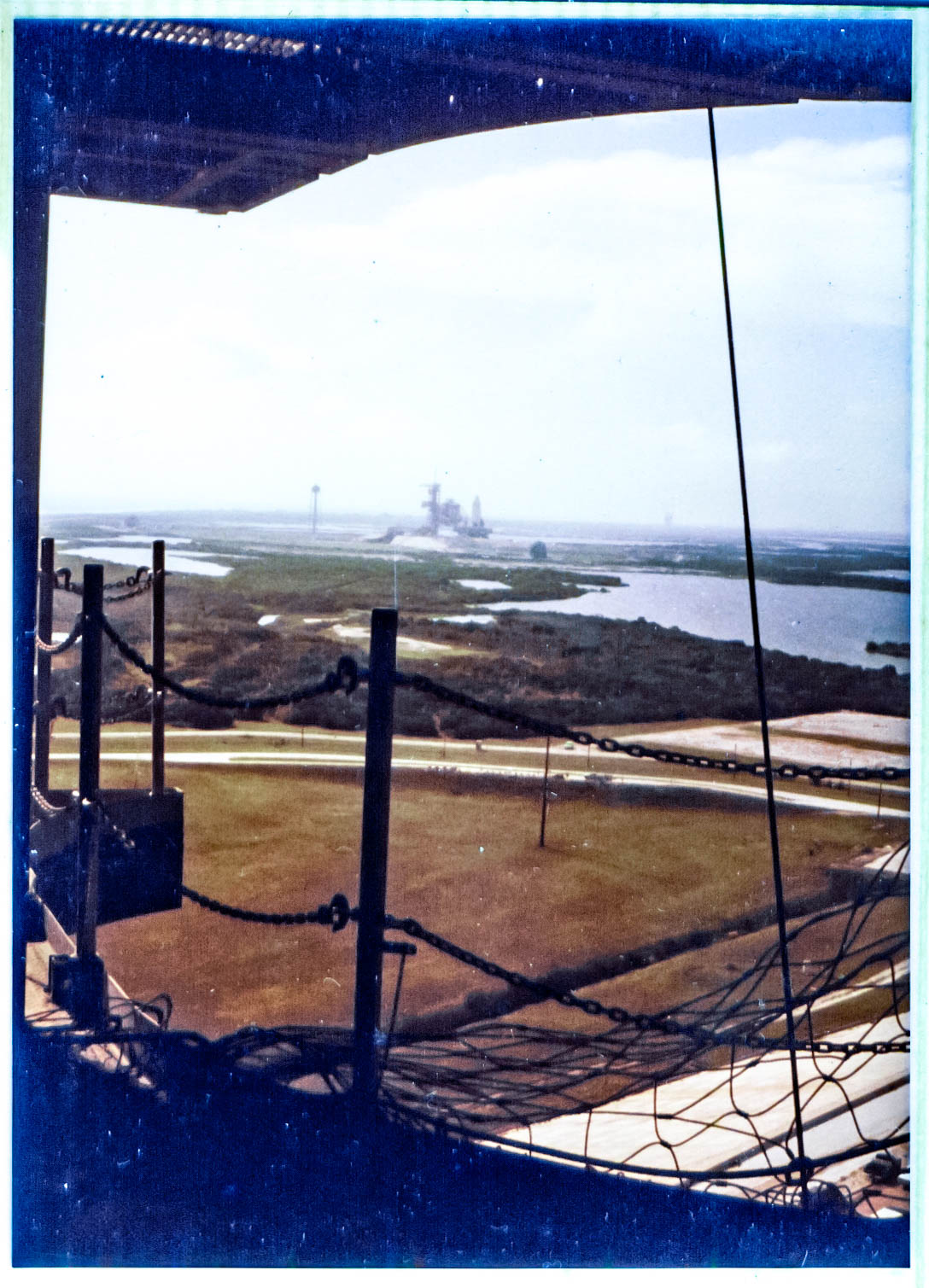
And now that I've successfully gotten my "insurance frame" I've moved over onto the RSS, into the RCS Room, for this frame.
Look close, compare this image to the previous one, and you can clearly see that the crawler which is carrying the MLP and Space Shuttle Stack has made some sensible progress in its journey to the top of the pad deck. It's slow, but it's inexorable, and had I dawdled very much longer at all, the stack would have moved out of proper view, hidden behind the RSS on Pad A, and that would have been the end of that.
And how 'bout those removable handrails and "safety" chains along the perimeter of the platform I'm shooting from?
Ye gods!
About all I can add in defense of this stuff is that at least the intermediate-level "safety" chains are actually midway between the deck and the top "safety" chain, so I suppose they've got that much going for them, at least.
And, at least here, they've gone ahead and have sort of haphazardly installed a bit of safety netting on part of the far side of the platform edge.
It can't be all bad, all the time, right?
Bottom Left:
(Full-size)
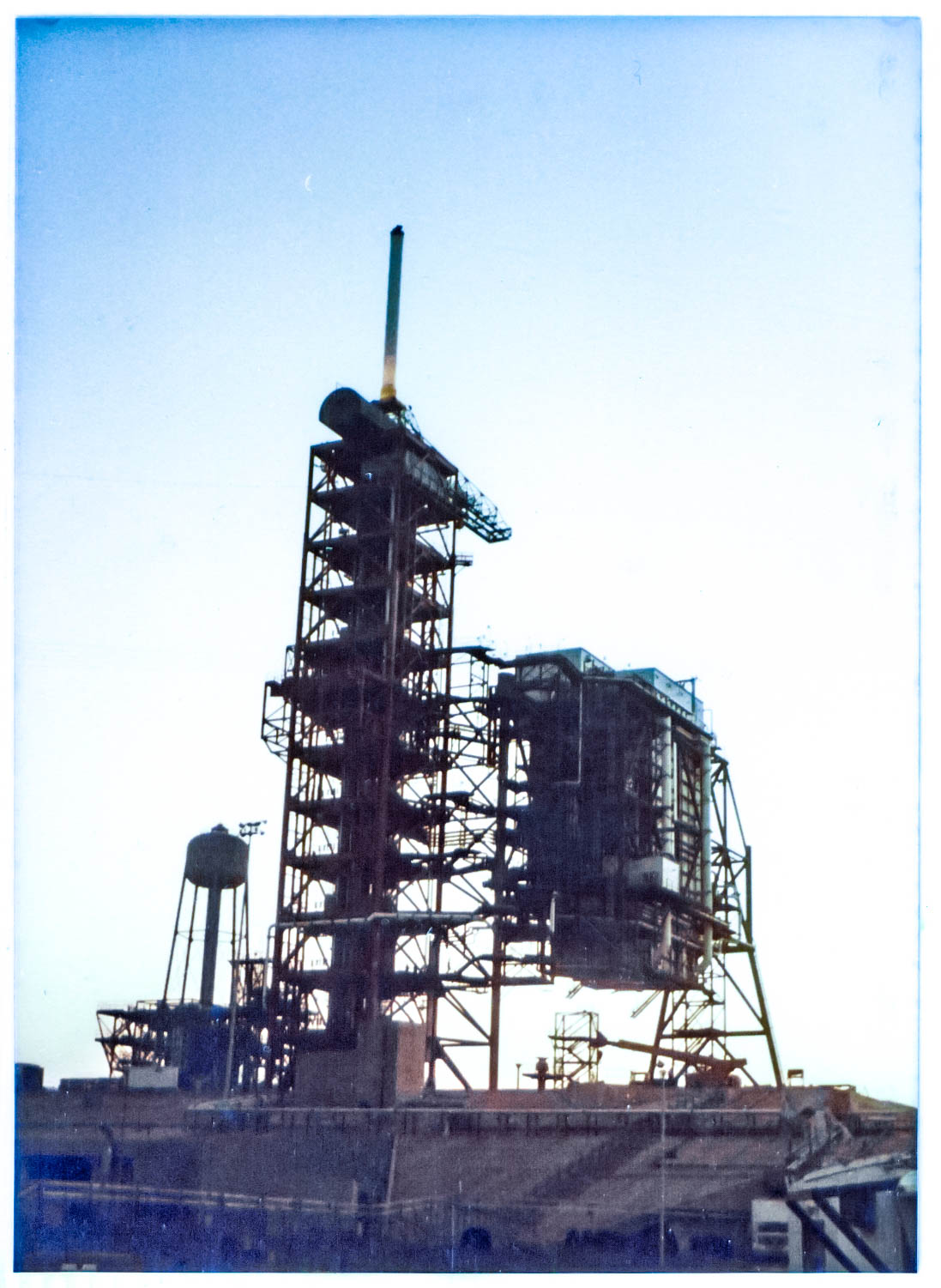
And now we'll step back in time several years, with me in the parking lot right in front of our field trailer, to a place where things looked much more spare and open.
It is the dawning of a new day.
The RSS is rotated around, into the mate position, which is a very uncommon thing, and was done only a very few times during the course of the construction effort.
Over on the FSS, no swing arms.
And a lot of early-morning sky light shining through the framing on the FSS, the RSS, the Hinge Column and Struts area, and column line 7 over on the far side of the RSS.
By the time we were done, and the pad went into operational status, one hell of a lot of additional equipment had been added to things. Without it, the structures almost look comprehensible. Almost look understandable, in particular the area of the Hinge Column & Struts.
Of note, the two "stairs of doom" proceeding down and to the left, at the very bottom of the RSS from the 112' level, can be seen plainly in silhouette. Once things had gone operational, the MLP would have been sitting right there, filling in and blocking out all of that sky light beneath the RSS, and those stairs would then let you take the one additional small step from their bottom risers neatly and evenly on to the nice solid steel deck plates of the MLP.
But not this morning.
And shall we talk about the safety gates, with their capacious oversize gap beneath them, down at the very bottom end of those stairs, which gap would be greatly favored as a passageway to the beyond for any poor soul whom gravity had determined should take the express route to the bottom of the stair? No. Let us not talk about the safety gates at the bottom of those stairs.
And it's pretty early in the morning, too. The sun may or may not even be above the horizon yet.
Look at the base of the lightning mast, and you can see the illumination of the lights that shine on it down at the bottom, to make it a bit more visible at night, should some fool chance along in a low-flying aircraft, perhaps not otherwise noticing the looming menace there before him.
Above and to the left of the top of the lightning mast, it looks almost like the crescent moon. But it is not. It is some sort of blemish on the photograph. It is in the wrong part of the sky, and is facing in the wrong direction as regards the location of the sun, which is out of frame below and to the right of what you're seeing in this image, so no, that's not the moon over there that you're seeing.
Between the dark masses of the FSS and RSS, no end of framing, piping, cable trays, platforms, and catwalks can be seen in stark silhouette against the bright sky behind them. At the very top of this confusing welter of zigzagging steel you can see the set of crossover platforms going from the 220' level on the FSS over to the 212' level on the RSS. The ones I was just talking about, up above. But notice, please, how very different their layout and aspect has become from what you've just seen, with the RSS in its retracted position, now that it has rotated around, through its full 120° pivoting length of travel, into the mated position. I've already said it too much, I'm sure, but I'm going to say it again: When that RSS moves, it becomes very easy to lose your way. Very easy to misapprehend things. Very easy to get into trouble.
And while we're here, zoom on in, look closely, and see if you can pick out the person, mid-traverse on a catwalk, going from the FSS to the RSS.
Bottom Right:
(Full-size)
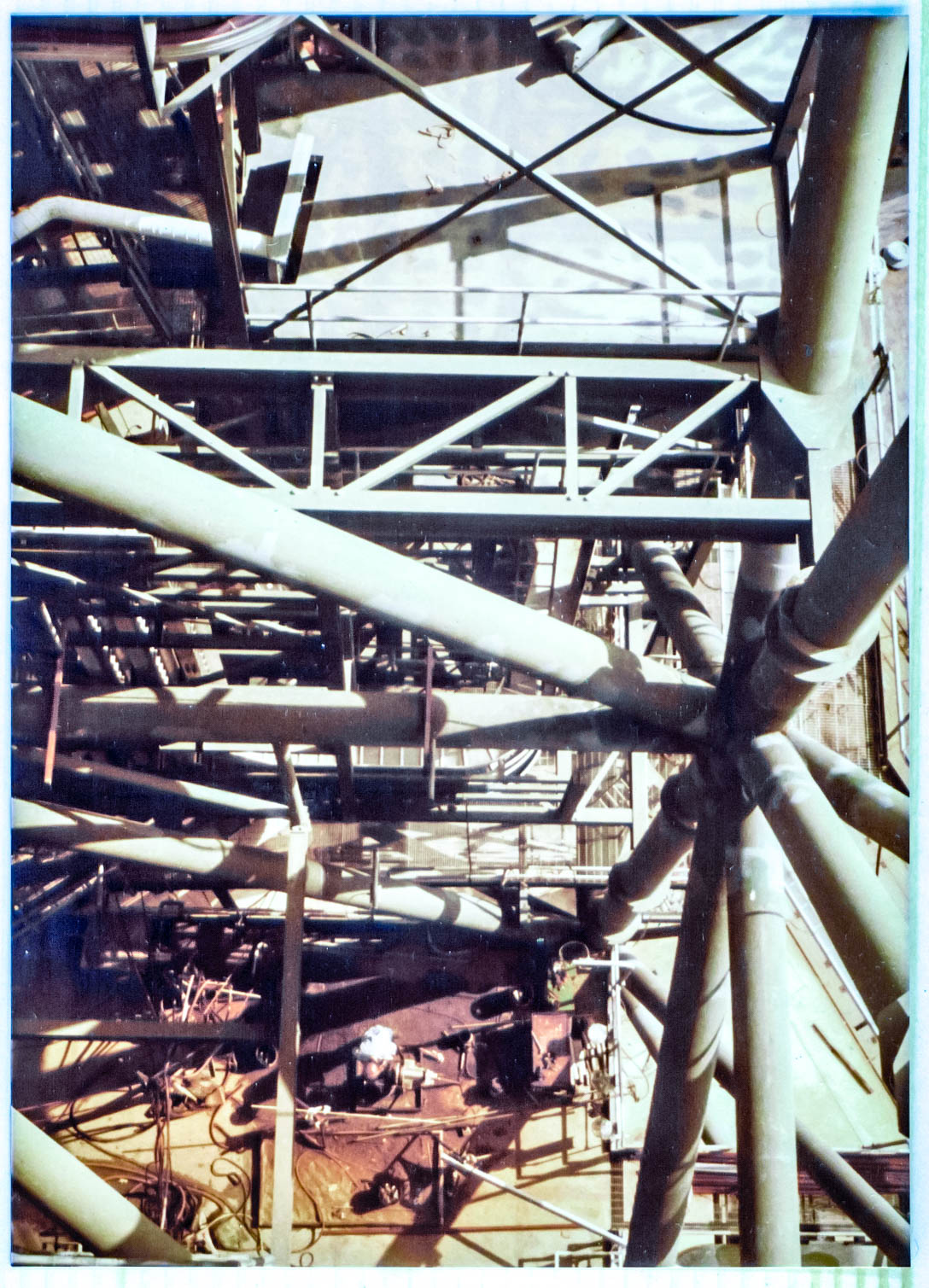
Welcome to my world.
This is what structural steel fabrication and erection looks like from the inside.
We're up on the top level of the RSS, closer to the front (Column Line B), than the back (Column Line A), looking down near-vertically in the direction of the Hinge Column (Column Line 1), which remains out of view, beyond the top of the frame.
Toward the top right of the frame is a ferociously complex connection of structural pipes (Ironworkers would occasionally call them "O-beams," as opposed to "I-beams.") which formed the main framing (as in it held everything else up) of the RSS. The way that all these heavy iron pipes come together results in a nightmare of exceedingly complex curved and beveled cuts and full-penetration welds to get the whole thing to snugly fit together properly, on-center, without error, to transfer the frightfully heavy loads produced by the weight of the entire finished structure down to solid ground in a safe and reliable manner.
Sheffield Steel produced and shipped this main framing, and Wilhoit erected it.
My very first foray out onto high steel, one crisp clear morning in the spring of 1980, involved me having to go ten or twenty feet across the top of one of the 24 inch pipes at the 135' level, between the Hinge Column and column line A along the back of the RSS, through an area where there was nothing whatsoever anywhere near or around me to grab hold of or lean up against, or even safely fall onto, and let me tell you, that curved round upper surface of the pipe is WAY more scary and dangerous than the nice flat level surface of a normal steel I-beam, which is plenty scary enough on its own for a first-timer, but I gulped hard, told myself to ignore the terrifying distance to the cool morning concrete and grass I could see a hundred feet beneath me as placid background for that awfully-curving top surface of the pipe, and Red Milliken, Wilhoit's general foreman, who saw the terror in my eyes, was extra careful and patient with me, and afforded me a grace to find and build the confidence to do what needed to be done on my own terms, and in the end all was well, but for a short while there..... you cannot imagine. You. Can. Not. Imagine. A thing such as this you must know by having gone through it for yourself, or you can not know it at all. Ironworkers, who can, with good reason, be classified as some of the meanest and roughest people on earth, also can, upon occasion, be deeply caring for the health and well-being of a fledgling, trying its wings out for the first time. These guys know, and really, that's all there is to it, and all that needs to be said about it.
Wilhoit's crew of ironworkers was sterling in general, and Red was as good as it gets, in particular.
In the shop, in Palatka, Florida, Sheffield Steel had to take raw steel structural pipe, plain, from the mill, and render it into things like the pipe connection which you see in this image.
Generally speaking, things like this arrived out at the pad in the form of "stub clusters," where the stubs of all the pipes extending out and away from the center of the connection were welded together in the fab shop, at the end of a single full-length member.
This particular stub cluster is located at elevation 171' at the intersection of column Line B and column line 2.
We're talking 1979, or perhaps the very early months of 1980, as the period of time when the fabrication of this heavy iron was underway, and all of this was done in the shop with pencil and paper, maybe a desk calculator, maybe a slide rule(!), using custom-built one-off templates and jigs, and the instincts of a couple of the old-timers to work out the details of it all, torch-cut, finish-grind and prep, precision-fit and rigidly-clamp the large and awkward tonnage of pipe stubs together, and then hand it off to their best master craftsmen welders to turn sweat, amps, fumes, hiss and crackle, molten metal, burn-inducingly intense ultraviolet light, and a delicate touch, into a single massive solid object by hand.
No computers. No robotics. No automatic welding rigs. No nothing.
Just some old guys in a dim, noisy, smoke-filled hall, going at it bare-handed.
The amount of skill and work required to produce a thing like this is vastly greater than you might imagine.
My respect for those people knows no bounds. None. None at all.
Maybe go get yourself nine cardboard paper-towel roll inserts (remember, one of them passes all the way through the cluster and comes out the other side) and cut them all up just so, and then glue them all together like the the cluster shown in this image, to within less than a degree of allowable error in alignment, keeping in mind that you're just playing around with cardboard and not having to deal with steel pipes having differing diameters and wall thicknesses, many of which being well over a foot and a half in diameter, some of which having a wall thickness of well over an inch, weighing in at over three-hundred pounds per running foot, and and then come back and we'll talk about what actually has to happen in order to make something like this appear in the real world, and then, Atlas-like, bear a tremendous load and do so safely and without problems of any kind.
Below, beyond, and to the left of the stub cluster can be seen what we were dealing with on a daily basis, in all of its apparently chaotic (but in fact, very tightly-organized) glory.
Part of me will always miss this place, but it's gone forever.
Eight stories below you, a zoom of the image will reveal the day-to-day details of a one five-hundredth of a second slice of the ongoing work on the towers.
Gang box, air hoses, conduits, beams, deckplate, steel bar grating, cord, ropes, pipes, a float, cable trays, posts, columns, primer-coated steel, gusset plates, clip angles, stiffener rings, high-strength structural bolts, power cords, explosion-proof lighting fixtures, air duct, buckets filled with bolts, tools, and trash, sticks of firex piping, loose cribbing lumber, hangers, knee-braces, handrails, emergency eye-wash station, catwalks, platforms, diagonals, full-penetration welds, crest of the flame deflector with spray headers, the pad deck, and even a gentleman in an orange hard hat, bent over his work, pursuing his trade.
It's all there, and more, too.
Return to 16streets.comACRONYMS LOOK-UP PAGEMaybe try to email me? |